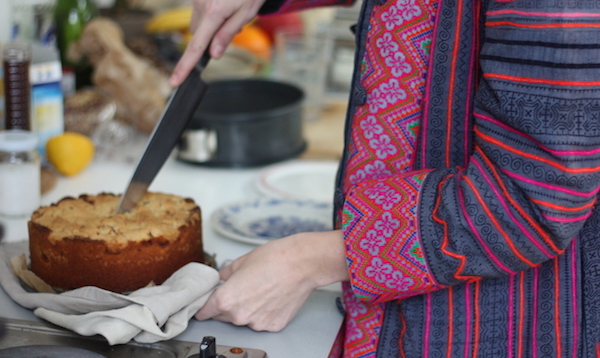Climbing three flights of stairs at Berlin’s Künstlerhaus Bethanien to visit Australian artist Elizabeth Willing’s live-in studio, I pass through corridors that have been traversed by so many artists before. Situated off the bustling Kottbusser Damm in the district of Kreuzberg, I meet Willing as she nears completion of her twelve month residency.
The Künstlerhaus Bethanien’s prestigious and highly competitive international studio program offers twenty-five international artists time and space to work on a fixed project, reflecting their experiences in Berlin. The institution’s strong standing within the global arts industry provides invaluable support and promotion for artists, and acts as a strong platform for launching careers. Previous Australian recipients include Sam Smith, Natascha Stellmach, Gerry Bibby, Claire Healy and Gabrielle de Vietri.

Elizabeth Willing’s studio at Künstlerhaus Bethanien (image courtesy Rachael Vance)
Upon opening the door I am greeted by a sun-drenched, spacious studio-cum-apartment. An oven timer ticks and the delightful smell of an apple teacake baking permeates the room – an apt setting for an artist who centres her practice on gastronomy and all things edible.
Taking some time out from the installation of her end-of-residency exhibition, a bubbly and upbeat Willing discusses her time spent in Berlin. The luxury of a year of freedom solely dedicated to her craft has been a dream come true for the artist. This ideal situation has been made all the more sweet for Willing due to the open plan space where “kitchen and studio are one.”

Elizabeth Willing’s studio at Künstlerhaus Bethanien (image courtesy Rachael Vance)
Willing is perhaps best known for previous interactive, ephemeral works revolving around collective food experiences, such as her participatory Dessert series and interactive installation Goosebump that invited gallery patrons to bite pfeffernüsse biscuits from gallery walls. The Brisbane-based artist has unequivocally carved out a niche with a practice which traces its lineage to creative endeavours that blur the boundaries between food and art. Artistic precedents utilising food as subject or material include the work of Renaissance painter Giuseppe Arcimboldo, The Futurists and their Manifesto of Futurist Cooking, contemporary artists Félix González-Torres and Shelley Miller, food designer duo Bompas & Parr and celebrity chef Heston Blumenthal.
Drawing on multi-sensory experiences in her sculptural works made from food, Willing is interested in the politics and extremes of the food industry – she cites food writer Michael Pollan as an inspiration. Becoming vegetarian at the age of twelve, being conscious about food has been a major part of Willing’s life. From haute cuisine to snack foods, candy and home-cooking, what was once a hobby and form of stress relief has become a major preoccupation. As someone who likens “a really good food experience to a really good art experience”, Willing’s position is one located within a formalist paradigm. The artist succinctly elucidates, “in my work I try to push the structural limits of food.” Triggering responses of delight, disgust and confrontation, notions of decay, consumption and materiality are inherent in her practice.

Elizabeth Willing, Cheese Sunset, 2014, 300 slices of processed cheese in 3 varieties, 180 x 78 cm (image courtesy Elizabeth Willing)
Amidst highly aromatic artificially coloured cheese slices and wormlike corn puffs transformed into sculptures, Willing discusses her inspirational mentorships spent with contemporary artists such as Janine Antoni and Thomas Rentmeister. Fascinated by avant-garde chefs like Ferran Adrià (of elBulli), she also spent time working with the Experimental Food Society in London. Likening this eye-opening induction into the world of culinary arts to a “religious experience”, the artist worked alongside food psychologist Professor Charles Spence and food designer Fernando Laposse.
An added layer implicit in Willing’s work is the desire to combine performance and sculpture, “to create sculptures that leave an impression of the performative process.” According to Willing, her pieces “tell a story about performance”, while also “expressing their own making.” She states further, “I like when the material has a quality that tells me how to work with it and I don’t have to add another element.” You can at once imagine how the corn puff sculptures in her studio have been licked together, and how the transparent straws mounted on the wall holding coloured drinks have been sucked through.

Elizabeth Willing in her studio at Künstlerhaus Bethanien (image courtesy Rachael Vance)
Willing’s enthusiasm for thinking about food within an art context is utterly contagious. The development of her practice whilst in Germany has seen Willing move away from a focus on confectionery and the purely sensual qualities of food. Revelling in discovering particular qualities of new materials, her research in Berlin has encompassed the exploration of countless supermarket aisles.
Another important part of the residency for Willing has been to gain an international perspective and connect to a broader arts community. She cites the Künstlerhaus Bethanien’s open studio evening as a highlight. Embracing the opportunity to talk about her work in different ways, Willing welcomed the general public, curators and writers into her studio. Above all, the residency has provided Willing with inspiration to “really enjoy making art again.” The alleviation of time and financial pressure for focused experimentation has brought with it an openness to failure, as Willing reveals, “I really got a lot of bad ideas out of the way in the beginning.” Not surprisingly, the artist established a pancake breakfast club ritual during her stay, inviting other artists into her studio to encourage a communal atmosphere. Willing continues to prove that you are never too old to play with your food.
Elizabeth Willing’s exhibition Shades of Yellow runs from 6-29 March 2015, Tue to Sun 2-7pm at the Künstlerhaus Bethanien exhibition spaces, Kottbusser Straße 10, 10999 Berlin.

Elizabeth Willing, 1000 licks, 2014, maize wurmen connected with saliva, 45 x 30 x 30 and 40 x 35 x 25 cm (image courtesy Elizabeth Willing)

